BSB113 Economics Semester 2 Essay: Micro Plastic Pollution from Tyres
VerifiedAdded on 2022/10/19
|9
|2200
|64
Essay
AI Summary
This essay delves into the issue of microplastic pollution stemming from the wear and tear of tyres, a significant contributor to environmental contamination. It highlights the economic concept of negative externality, illustrating how the use of private cars generates microplastics, which harm aquatic life, humans, and the overall environment. The essay uses economic diagrams to explain the negative externality and proposes several policy solutions, including limiting the number of cars, promoting public transport, and implementing road taxes, to shift the market equilibrium towards a socially efficient outcome. The essay emphasizes the need for immediate action and innovation to mitigate the adverse effects of microplastic pollution, recognizing the increasing volume of microplastics with the rise in car usage and the potential exacerbation of the problem with heavier electric vehicles. It underscores the importance of addressing this issue to safeguard both the environment and human health, referencing several studies and reports to support its arguments.
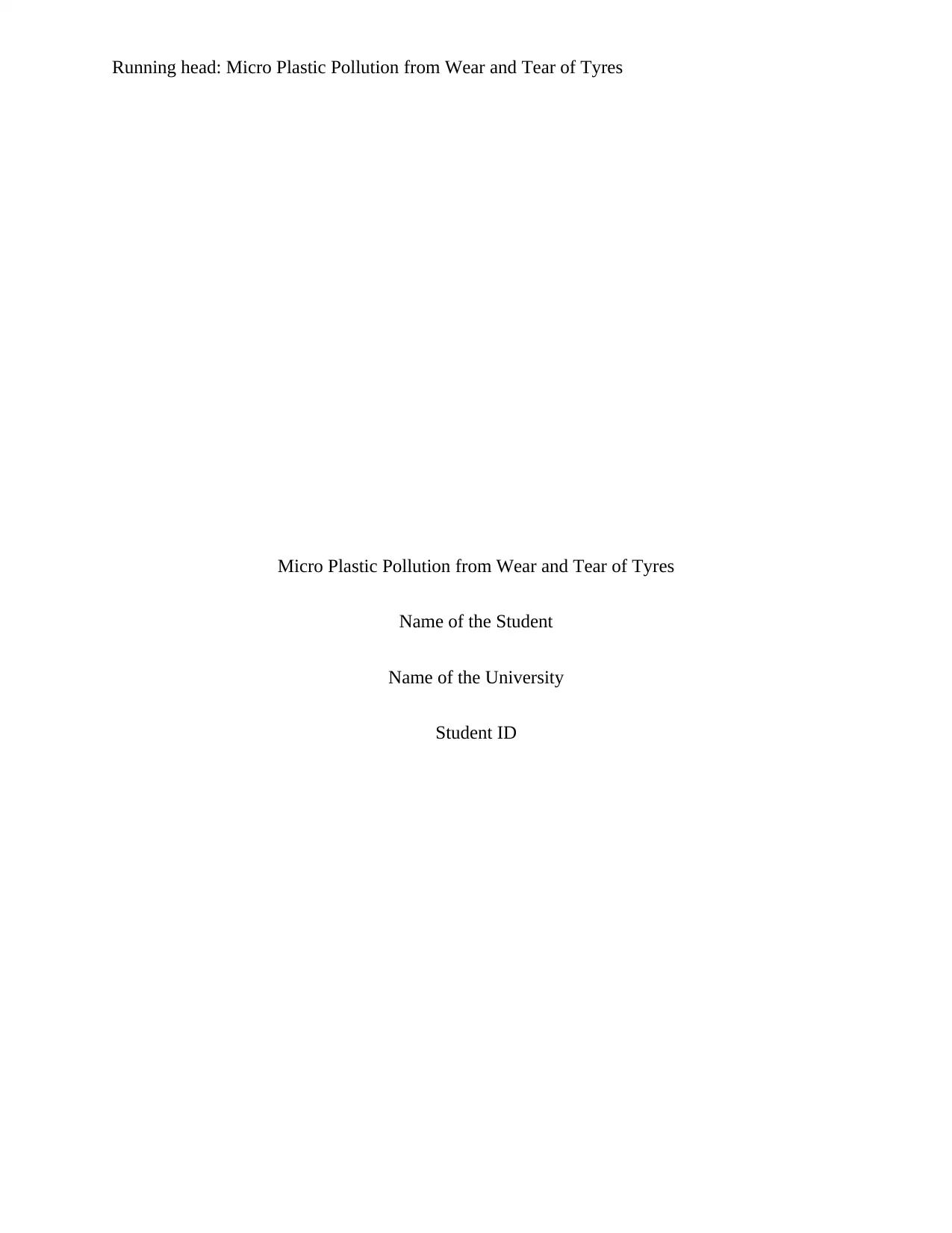
Running head: Micro Plastic Pollution from Wear and Tear of Tyres
Micro Plastic Pollution from Wear and Tear of Tyres
Name of the Student
Name of the University
Student ID
Micro Plastic Pollution from Wear and Tear of Tyres
Name of the Student
Name of the University
Student ID
Paraphrase This Document
Need a fresh take? Get an instant paraphrase of this document with our AI Paraphraser
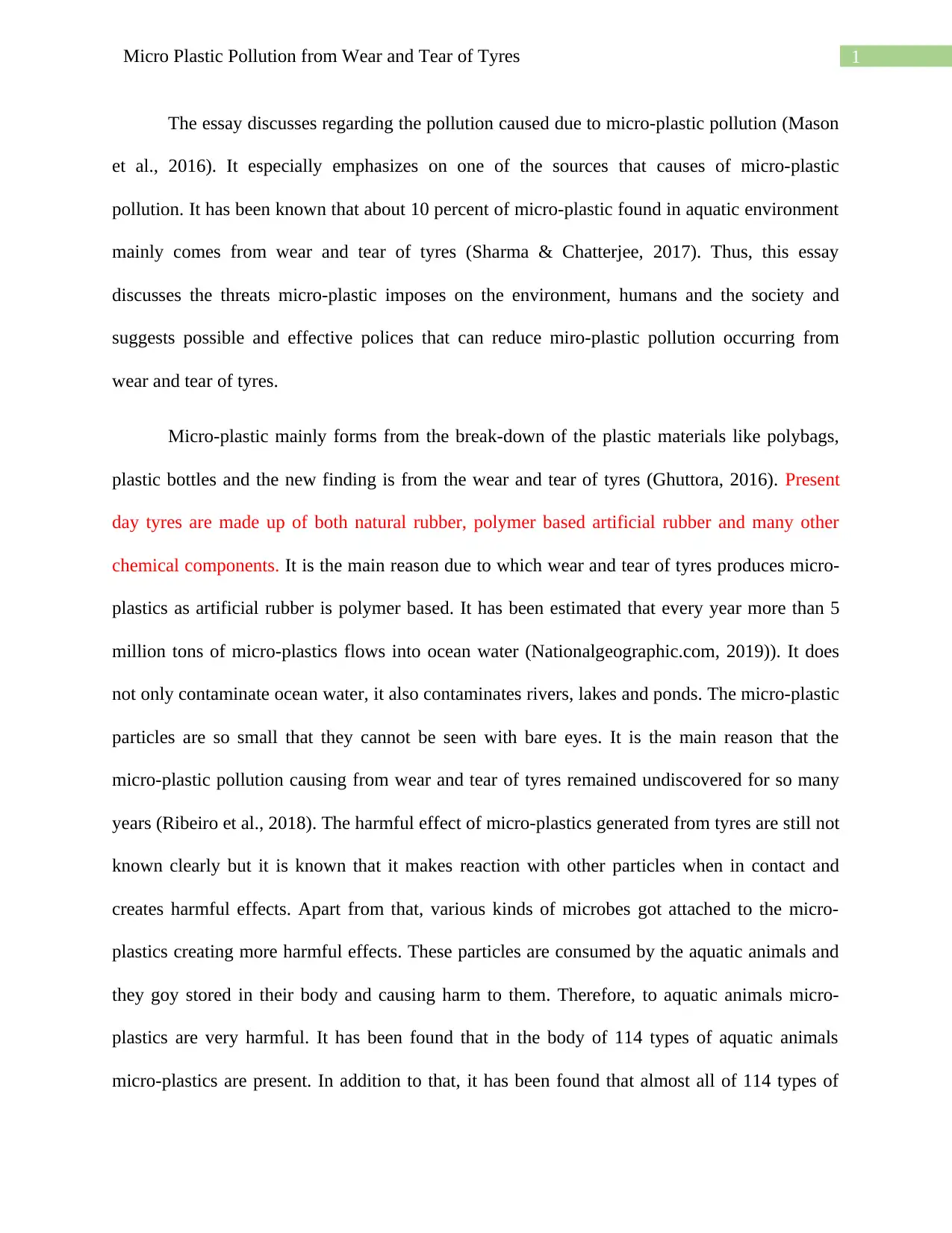
1Micro Plastic Pollution from Wear and Tear of Tyres
The essay discusses regarding the pollution caused due to micro-plastic pollution (Mason
et al., 2016). It especially emphasizes on one of the sources that causes of micro-plastic
pollution. It has been known that about 10 percent of micro-plastic found in aquatic environment
mainly comes from wear and tear of tyres (Sharma & Chatterjee, 2017). Thus, this essay
discusses the threats micro-plastic imposes on the environment, humans and the society and
suggests possible and effective polices that can reduce miro-plastic pollution occurring from
wear and tear of tyres.
Micro-plastic mainly forms from the break-down of the plastic materials like polybags,
plastic bottles and the new finding is from the wear and tear of tyres (Ghuttora, 2016). Present
day tyres are made up of both natural rubber, polymer based artificial rubber and many other
chemical components. It is the main reason due to which wear and tear of tyres produces micro-
plastics as artificial rubber is polymer based. It has been estimated that every year more than 5
million tons of micro-plastics flows into ocean water (Nationalgeographic.com, 2019)). It does
not only contaminate ocean water, it also contaminates rivers, lakes and ponds. The micro-plastic
particles are so small that they cannot be seen with bare eyes. It is the main reason that the
micro-plastic pollution causing from wear and tear of tyres remained undiscovered for so many
years (Ribeiro et al., 2018). The harmful effect of micro-plastics generated from tyres are still not
known clearly but it is known that it makes reaction with other particles when in contact and
creates harmful effects. Apart from that, various kinds of microbes got attached to the micro-
plastics creating more harmful effects. These particles are consumed by the aquatic animals and
they goy stored in their body and causing harm to them. Therefore, to aquatic animals micro-
plastics are very harmful. It has been found that in the body of 114 types of aquatic animals
micro-plastics are present. In addition to that, it has been found that almost all of 114 types of
The essay discusses regarding the pollution caused due to micro-plastic pollution (Mason
et al., 2016). It especially emphasizes on one of the sources that causes of micro-plastic
pollution. It has been known that about 10 percent of micro-plastic found in aquatic environment
mainly comes from wear and tear of tyres (Sharma & Chatterjee, 2017). Thus, this essay
discusses the threats micro-plastic imposes on the environment, humans and the society and
suggests possible and effective polices that can reduce miro-plastic pollution occurring from
wear and tear of tyres.
Micro-plastic mainly forms from the break-down of the plastic materials like polybags,
plastic bottles and the new finding is from the wear and tear of tyres (Ghuttora, 2016). Present
day tyres are made up of both natural rubber, polymer based artificial rubber and many other
chemical components. It is the main reason due to which wear and tear of tyres produces micro-
plastics as artificial rubber is polymer based. It has been estimated that every year more than 5
million tons of micro-plastics flows into ocean water (Nationalgeographic.com, 2019)). It does
not only contaminate ocean water, it also contaminates rivers, lakes and ponds. The micro-plastic
particles are so small that they cannot be seen with bare eyes. It is the main reason that the
micro-plastic pollution causing from wear and tear of tyres remained undiscovered for so many
years (Ribeiro et al., 2018). The harmful effect of micro-plastics generated from tyres are still not
known clearly but it is known that it makes reaction with other particles when in contact and
creates harmful effects. Apart from that, various kinds of microbes got attached to the micro-
plastics creating more harmful effects. These particles are consumed by the aquatic animals and
they goy stored in their body and causing harm to them. Therefore, to aquatic animals micro-
plastics are very harmful. It has been found that in the body of 114 types of aquatic animals
micro-plastics are present. In addition to that, it has been found that almost all of 114 types of
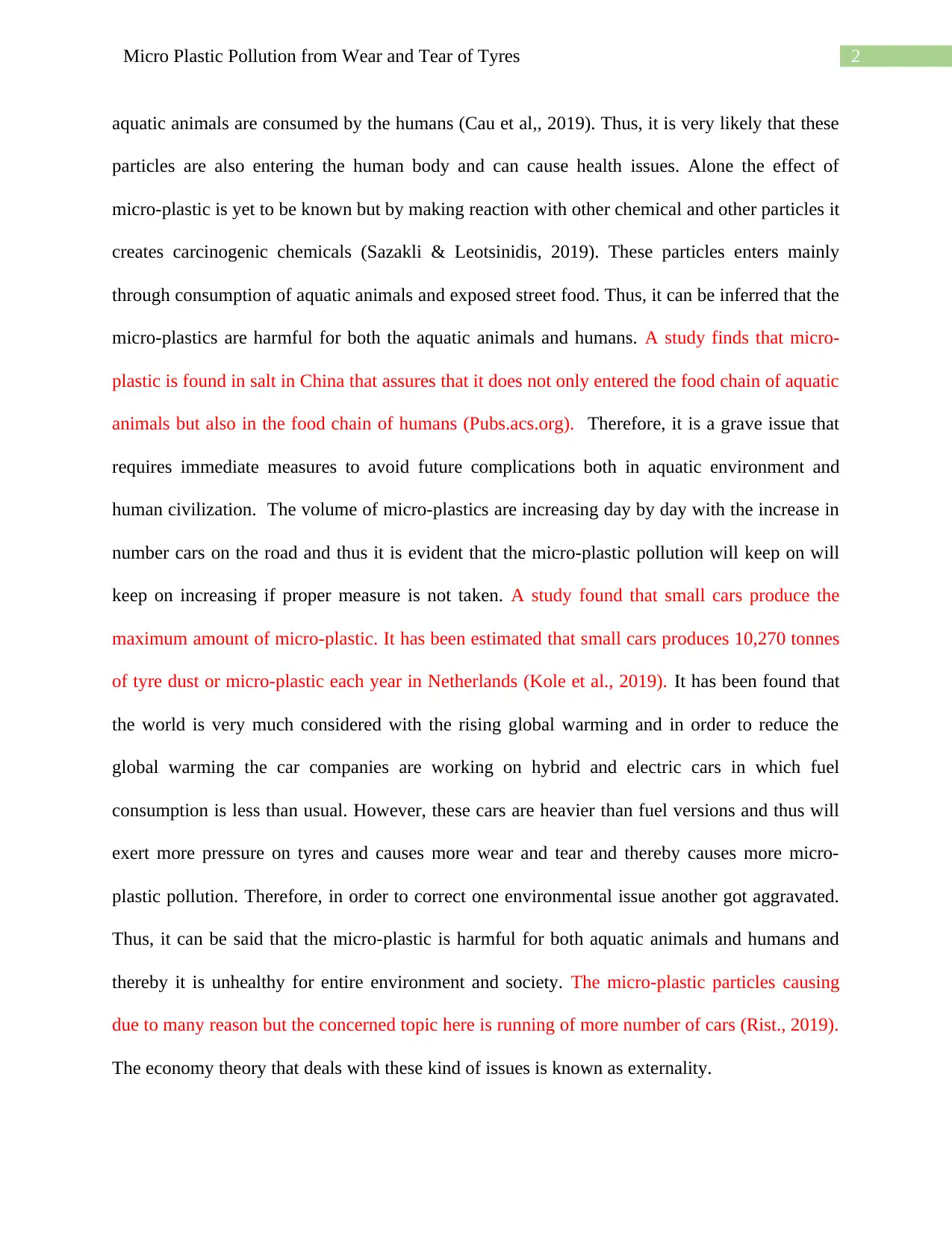
2Micro Plastic Pollution from Wear and Tear of Tyres
aquatic animals are consumed by the humans (Cau et al,, 2019). Thus, it is very likely that these
particles are also entering the human body and can cause health issues. Alone the effect of
micro-plastic is yet to be known but by making reaction with other chemical and other particles it
creates carcinogenic chemicals (Sazakli & Leotsinidis, 2019). These particles enters mainly
through consumption of aquatic animals and exposed street food. Thus, it can be inferred that the
micro-plastics are harmful for both the aquatic animals and humans. A study finds that micro-
plastic is found in salt in China that assures that it does not only entered the food chain of aquatic
animals but also in the food chain of humans (Pubs.acs.org). Therefore, it is a grave issue that
requires immediate measures to avoid future complications both in aquatic environment and
human civilization. The volume of micro-plastics are increasing day by day with the increase in
number cars on the road and thus it is evident that the micro-plastic pollution will keep on will
keep on increasing if proper measure is not taken. A study found that small cars produce the
maximum amount of micro-plastic. It has been estimated that small cars produces 10,270 tonnes
of tyre dust or micro-plastic each year in Netherlands (Kole et al., 2019). It has been found that
the world is very much considered with the rising global warming and in order to reduce the
global warming the car companies are working on hybrid and electric cars in which fuel
consumption is less than usual. However, these cars are heavier than fuel versions and thus will
exert more pressure on tyres and causes more wear and tear and thereby causes more micro-
plastic pollution. Therefore, in order to correct one environmental issue another got aggravated.
Thus, it can be said that the micro-plastic is harmful for both aquatic animals and humans and
thereby it is unhealthy for entire environment and society. The micro-plastic particles causing
due to many reason but the concerned topic here is running of more number of cars (Rist., 2019).
The economy theory that deals with these kind of issues is known as externality.
aquatic animals are consumed by the humans (Cau et al,, 2019). Thus, it is very likely that these
particles are also entering the human body and can cause health issues. Alone the effect of
micro-plastic is yet to be known but by making reaction with other chemical and other particles it
creates carcinogenic chemicals (Sazakli & Leotsinidis, 2019). These particles enters mainly
through consumption of aquatic animals and exposed street food. Thus, it can be inferred that the
micro-plastics are harmful for both the aquatic animals and humans. A study finds that micro-
plastic is found in salt in China that assures that it does not only entered the food chain of aquatic
animals but also in the food chain of humans (Pubs.acs.org). Therefore, it is a grave issue that
requires immediate measures to avoid future complications both in aquatic environment and
human civilization. The volume of micro-plastics are increasing day by day with the increase in
number cars on the road and thus it is evident that the micro-plastic pollution will keep on will
keep on increasing if proper measure is not taken. A study found that small cars produce the
maximum amount of micro-plastic. It has been estimated that small cars produces 10,270 tonnes
of tyre dust or micro-plastic each year in Netherlands (Kole et al., 2019). It has been found that
the world is very much considered with the rising global warming and in order to reduce the
global warming the car companies are working on hybrid and electric cars in which fuel
consumption is less than usual. However, these cars are heavier than fuel versions and thus will
exert more pressure on tyres and causes more wear and tear and thereby causes more micro-
plastic pollution. Therefore, in order to correct one environmental issue another got aggravated.
Thus, it can be said that the micro-plastic is harmful for both aquatic animals and humans and
thereby it is unhealthy for entire environment and society. The micro-plastic particles causing
due to many reason but the concerned topic here is running of more number of cars (Rist., 2019).
The economy theory that deals with these kind of issues is known as externality.
⊘ This is a preview!⊘
Do you want full access?
Subscribe today to unlock all pages.

Trusted by 1+ million students worldwide
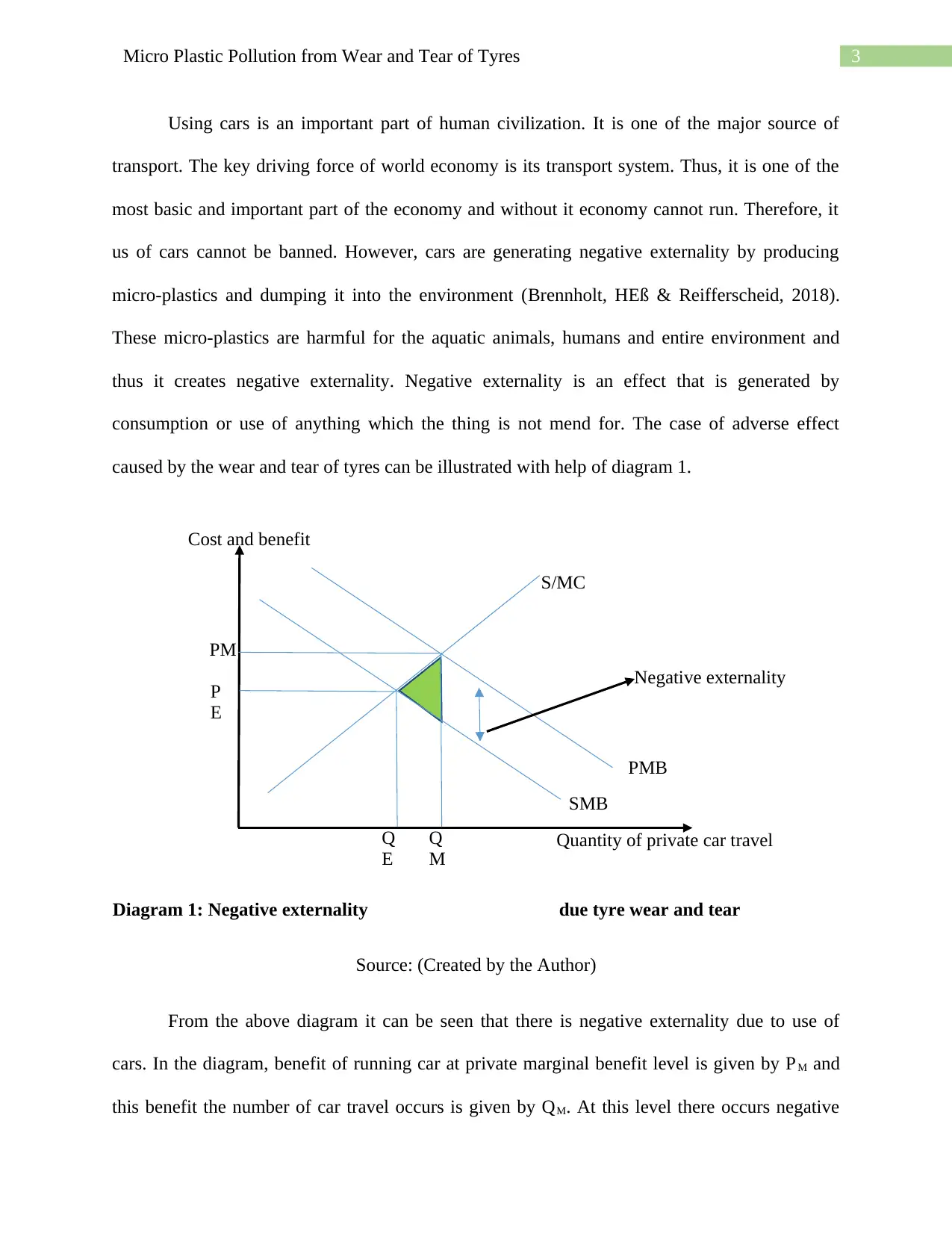
3Micro Plastic Pollution from Wear and Tear of Tyres
Negative externality
Quantity of private car travel
Cost and benefit
PM
Q
M
Q
E
P
E
SMB
PMB
S/MC
Using cars is an important part of human civilization. It is one of the major source of
transport. The key driving force of world economy is its transport system. Thus, it is one of the
most basic and important part of the economy and without it economy cannot run. Therefore, it
us of cars cannot be banned. However, cars are generating negative externality by producing
micro-plastics and dumping it into the environment (Brennholt, HEß & Reifferscheid, 2018).
These micro-plastics are harmful for the aquatic animals, humans and entire environment and
thus it creates negative externality. Negative externality is an effect that is generated by
consumption or use of anything which the thing is not mend for. The case of adverse effect
caused by the wear and tear of tyres can be illustrated with help of diagram 1.
Diagram 1: Negative externality due tyre wear and tear
Source: (Created by the Author)
From the above diagram it can be seen that there is negative externality due to use of
cars. In the diagram, benefit of running car at private marginal benefit level is given by PM and
this benefit the number of car travel occurs is given by QM. At this level there occurs negative
Negative externality
Quantity of private car travel
Cost and benefit
PM
Q
M
Q
E
P
E
SMB
PMB
S/MC
Using cars is an important part of human civilization. It is one of the major source of
transport. The key driving force of world economy is its transport system. Thus, it is one of the
most basic and important part of the economy and without it economy cannot run. Therefore, it
us of cars cannot be banned. However, cars are generating negative externality by producing
micro-plastics and dumping it into the environment (Brennholt, HEß & Reifferscheid, 2018).
These micro-plastics are harmful for the aquatic animals, humans and entire environment and
thus it creates negative externality. Negative externality is an effect that is generated by
consumption or use of anything which the thing is not mend for. The case of adverse effect
caused by the wear and tear of tyres can be illustrated with help of diagram 1.
Diagram 1: Negative externality due tyre wear and tear
Source: (Created by the Author)
From the above diagram it can be seen that there is negative externality due to use of
cars. In the diagram, benefit of running car at private marginal benefit level is given by PM and
this benefit the number of car travel occurs is given by QM. At this level there occurs negative
Paraphrase This Document
Need a fresh take? Get an instant paraphrase of this document with our AI Paraphraser
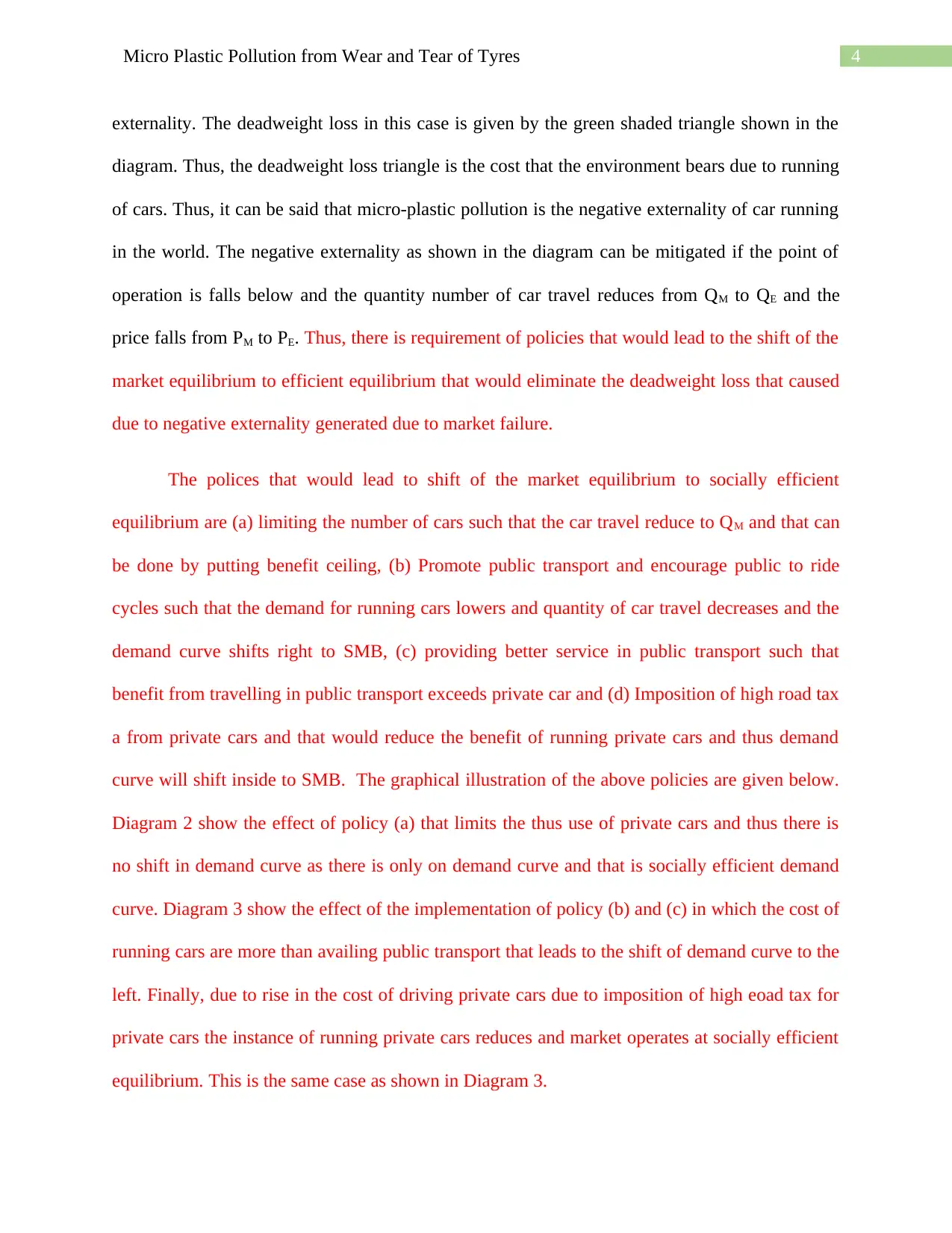
4Micro Plastic Pollution from Wear and Tear of Tyres
externality. The deadweight loss in this case is given by the green shaded triangle shown in the
diagram. Thus, the deadweight loss triangle is the cost that the environment bears due to running
of cars. Thus, it can be said that micro-plastic pollution is the negative externality of car running
in the world. The negative externality as shown in the diagram can be mitigated if the point of
operation is falls below and the quantity number of car travel reduces from QM to QE and the
price falls from PM to PE. Thus, there is requirement of policies that would lead to the shift of the
market equilibrium to efficient equilibrium that would eliminate the deadweight loss that caused
due to negative externality generated due to market failure.
The polices that would lead to shift of the market equilibrium to socially efficient
equilibrium are (a) limiting the number of cars such that the car travel reduce to QM and that can
be done by putting benefit ceiling, (b) Promote public transport and encourage public to ride
cycles such that the demand for running cars lowers and quantity of car travel decreases and the
demand curve shifts right to SMB, (c) providing better service in public transport such that
benefit from travelling in public transport exceeds private car and (d) Imposition of high road tax
a from private cars and that would reduce the benefit of running private cars and thus demand
curve will shift inside to SMB. The graphical illustration of the above policies are given below.
Diagram 2 show the effect of policy (a) that limits the thus use of private cars and thus there is
no shift in demand curve as there is only on demand curve and that is socially efficient demand
curve. Diagram 3 show the effect of the implementation of policy (b) and (c) in which the cost of
running cars are more than availing public transport that leads to the shift of demand curve to the
left. Finally, due to rise in the cost of driving private cars due to imposition of high eoad tax for
private cars the instance of running private cars reduces and market operates at socially efficient
equilibrium. This is the same case as shown in Diagram 3.
externality. The deadweight loss in this case is given by the green shaded triangle shown in the
diagram. Thus, the deadweight loss triangle is the cost that the environment bears due to running
of cars. Thus, it can be said that micro-plastic pollution is the negative externality of car running
in the world. The negative externality as shown in the diagram can be mitigated if the point of
operation is falls below and the quantity number of car travel reduces from QM to QE and the
price falls from PM to PE. Thus, there is requirement of policies that would lead to the shift of the
market equilibrium to efficient equilibrium that would eliminate the deadweight loss that caused
due to negative externality generated due to market failure.
The polices that would lead to shift of the market equilibrium to socially efficient
equilibrium are (a) limiting the number of cars such that the car travel reduce to QM and that can
be done by putting benefit ceiling, (b) Promote public transport and encourage public to ride
cycles such that the demand for running cars lowers and quantity of car travel decreases and the
demand curve shifts right to SMB, (c) providing better service in public transport such that
benefit from travelling in public transport exceeds private car and (d) Imposition of high road tax
a from private cars and that would reduce the benefit of running private cars and thus demand
curve will shift inside to SMB. The graphical illustration of the above policies are given below.
Diagram 2 show the effect of policy (a) that limits the thus use of private cars and thus there is
no shift in demand curve as there is only on demand curve and that is socially efficient demand
curve. Diagram 3 show the effect of the implementation of policy (b) and (c) in which the cost of
running cars are more than availing public transport that leads to the shift of demand curve to the
left. Finally, due to rise in the cost of driving private cars due to imposition of high eoad tax for
private cars the instance of running private cars reduces and market operates at socially efficient
equilibrium. This is the same case as shown in Diagram 3.
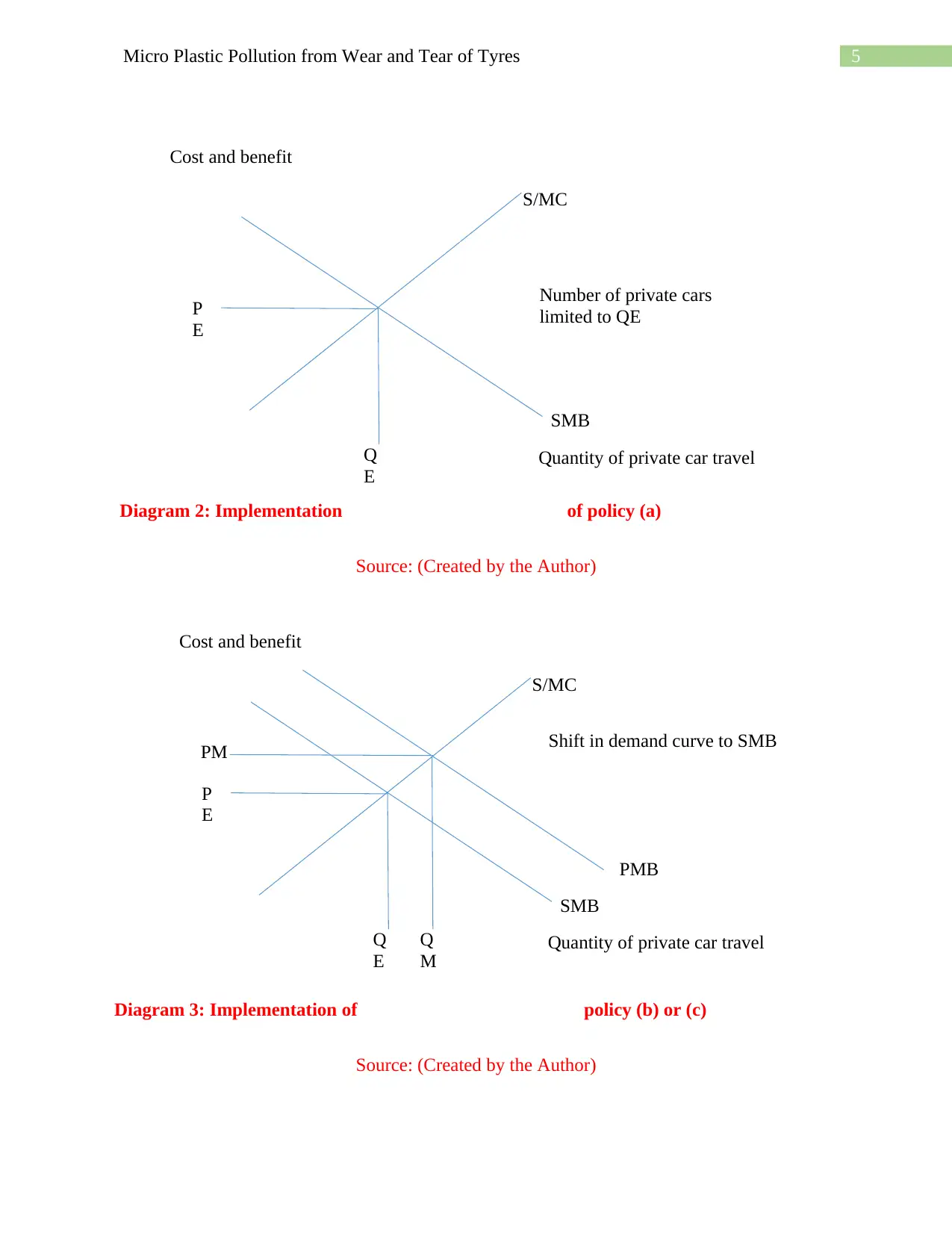
5Micro Plastic Pollution from Wear and Tear of Tyres
Quantity of private car travel
Cost and benefit
Q
E
P
E
SMB
S/MC
Number of private cars
limited to QE
Shift in demand curve to SMB
Quantity of private car travel
Cost and benefit
PM
Q
M
Q
E
P
E
SMB
PMB
S/MC
Diagram 2: Implementation of policy (a)
Source: (Created by the Author)
Diagram 3: Implementation of policy (b) or (c)
Source: (Created by the Author)
Quantity of private car travel
Cost and benefit
Q
E
P
E
SMB
S/MC
Number of private cars
limited to QE
Shift in demand curve to SMB
Quantity of private car travel
Cost and benefit
PM
Q
M
Q
E
P
E
SMB
PMB
S/MC
Diagram 2: Implementation of policy (a)
Source: (Created by the Author)
Diagram 3: Implementation of policy (b) or (c)
Source: (Created by the Author)
⊘ This is a preview!⊘
Do you want full access?
Subscribe today to unlock all pages.

Trusted by 1+ million students worldwide
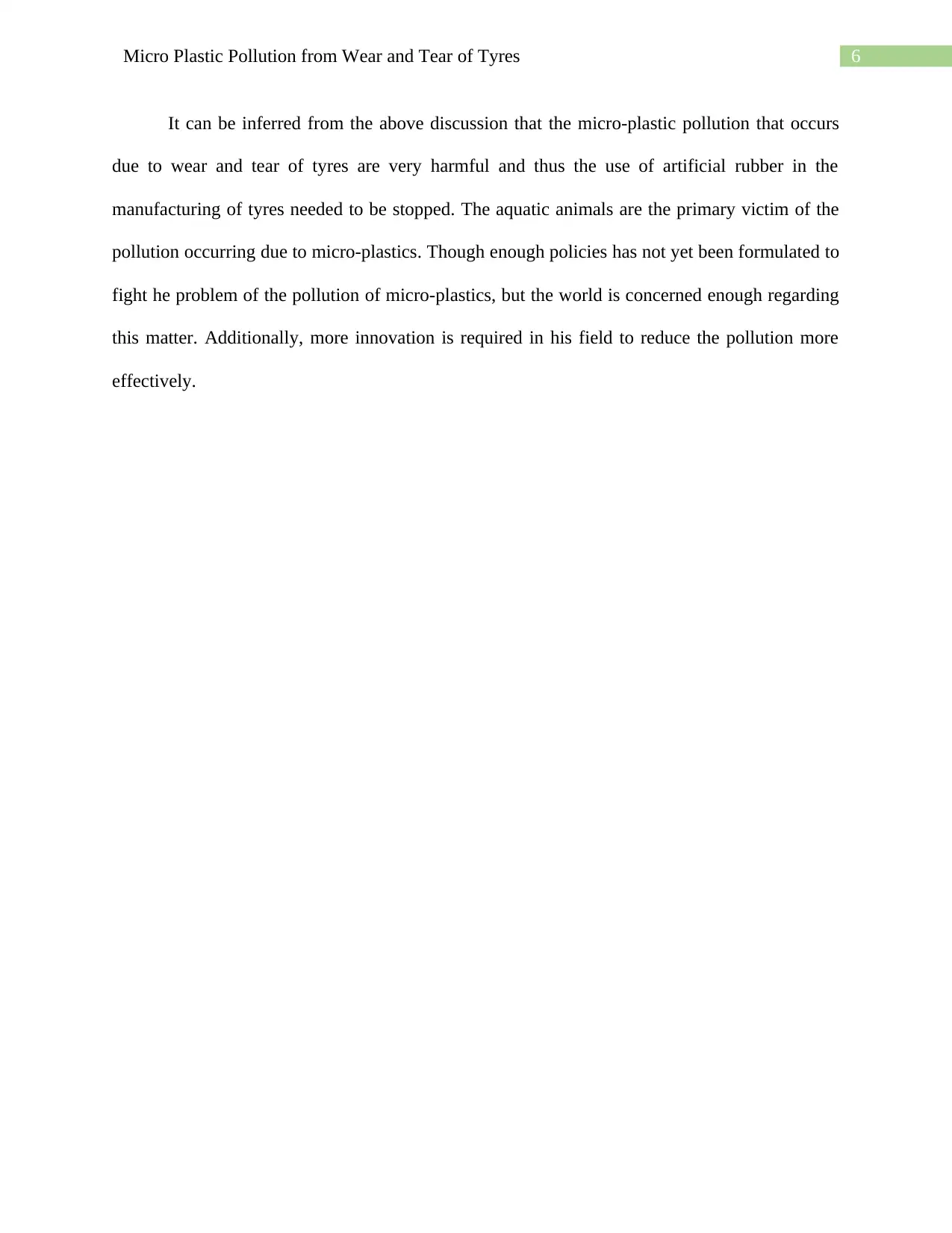
6Micro Plastic Pollution from Wear and Tear of Tyres
It can be inferred from the above discussion that the micro-plastic pollution that occurs
due to wear and tear of tyres are very harmful and thus the use of artificial rubber in the
manufacturing of tyres needed to be stopped. The aquatic animals are the primary victim of the
pollution occurring due to micro-plastics. Though enough policies has not yet been formulated to
fight he problem of the pollution of micro-plastics, but the world is concerned enough regarding
this matter. Additionally, more innovation is required in his field to reduce the pollution more
effectively.
It can be inferred from the above discussion that the micro-plastic pollution that occurs
due to wear and tear of tyres are very harmful and thus the use of artificial rubber in the
manufacturing of tyres needed to be stopped. The aquatic animals are the primary victim of the
pollution occurring due to micro-plastics. Though enough policies has not yet been formulated to
fight he problem of the pollution of micro-plastics, but the world is concerned enough regarding
this matter. Additionally, more innovation is required in his field to reduce the pollution more
effectively.
Paraphrase This Document
Need a fresh take? Get an instant paraphrase of this document with our AI Paraphraser
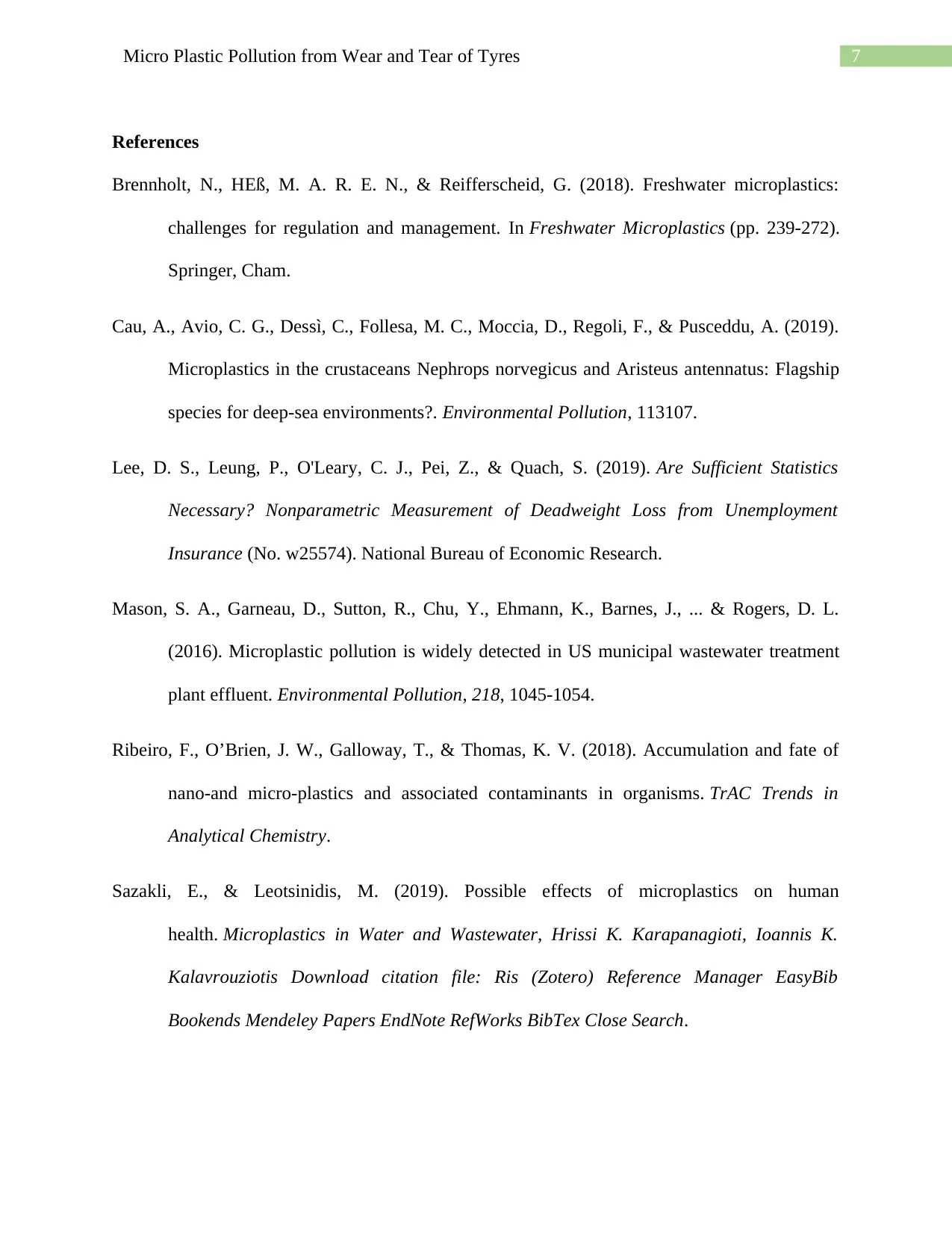
7Micro Plastic Pollution from Wear and Tear of Tyres
References
Brennholt, N., HEß, M. A. R. E. N., & Reifferscheid, G. (2018). Freshwater microplastics:
challenges for regulation and management. In Freshwater Microplastics (pp. 239-272).
Springer, Cham.
Cau, A., Avio, C. G., Dessì, C., Follesa, M. C., Moccia, D., Regoli, F., & Pusceddu, A. (2019).
Microplastics in the crustaceans Nephrops norvegicus and Aristeus antennatus: Flagship
species for deep-sea environments?. Environmental Pollution, 113107.
Lee, D. S., Leung, P., O'Leary, C. J., Pei, Z., & Quach, S. (2019). Are Sufficient Statistics
Necessary? Nonparametric Measurement of Deadweight Loss from Unemployment
Insurance (No. w25574). National Bureau of Economic Research.
Mason, S. A., Garneau, D., Sutton, R., Chu, Y., Ehmann, K., Barnes, J., ... & Rogers, D. L.
(2016). Microplastic pollution is widely detected in US municipal wastewater treatment
plant effluent. Environmental Pollution, 218, 1045-1054.
Ribeiro, F., O’Brien, J. W., Galloway, T., & Thomas, K. V. (2018). Accumulation and fate of
nano-and micro-plastics and associated contaminants in organisms. TrAC Trends in
Analytical Chemistry.
Sazakli, E., & Leotsinidis, M. (2019). Possible effects of microplastics on human
health. Microplastics in Water and Wastewater, Hrissi K. Karapanagioti, Ioannis K.
Kalavrouziotis Download citation file: Ris (Zotero) Reference Manager EasyBib
Bookends Mendeley Papers EndNote RefWorks BibTex Close Search.
References
Brennholt, N., HEß, M. A. R. E. N., & Reifferscheid, G. (2018). Freshwater microplastics:
challenges for regulation and management. In Freshwater Microplastics (pp. 239-272).
Springer, Cham.
Cau, A., Avio, C. G., Dessì, C., Follesa, M. C., Moccia, D., Regoli, F., & Pusceddu, A. (2019).
Microplastics in the crustaceans Nephrops norvegicus and Aristeus antennatus: Flagship
species for deep-sea environments?. Environmental Pollution, 113107.
Lee, D. S., Leung, P., O'Leary, C. J., Pei, Z., & Quach, S. (2019). Are Sufficient Statistics
Necessary? Nonparametric Measurement of Deadweight Loss from Unemployment
Insurance (No. w25574). National Bureau of Economic Research.
Mason, S. A., Garneau, D., Sutton, R., Chu, Y., Ehmann, K., Barnes, J., ... & Rogers, D. L.
(2016). Microplastic pollution is widely detected in US municipal wastewater treatment
plant effluent. Environmental Pollution, 218, 1045-1054.
Ribeiro, F., O’Brien, J. W., Galloway, T., & Thomas, K. V. (2018). Accumulation and fate of
nano-and micro-plastics and associated contaminants in organisms. TrAC Trends in
Analytical Chemistry.
Sazakli, E., & Leotsinidis, M. (2019). Possible effects of microplastics on human
health. Microplastics in Water and Wastewater, Hrissi K. Karapanagioti, Ioannis K.
Kalavrouziotis Download citation file: Ris (Zotero) Reference Manager EasyBib
Bookends Mendeley Papers EndNote RefWorks BibTex Close Search.
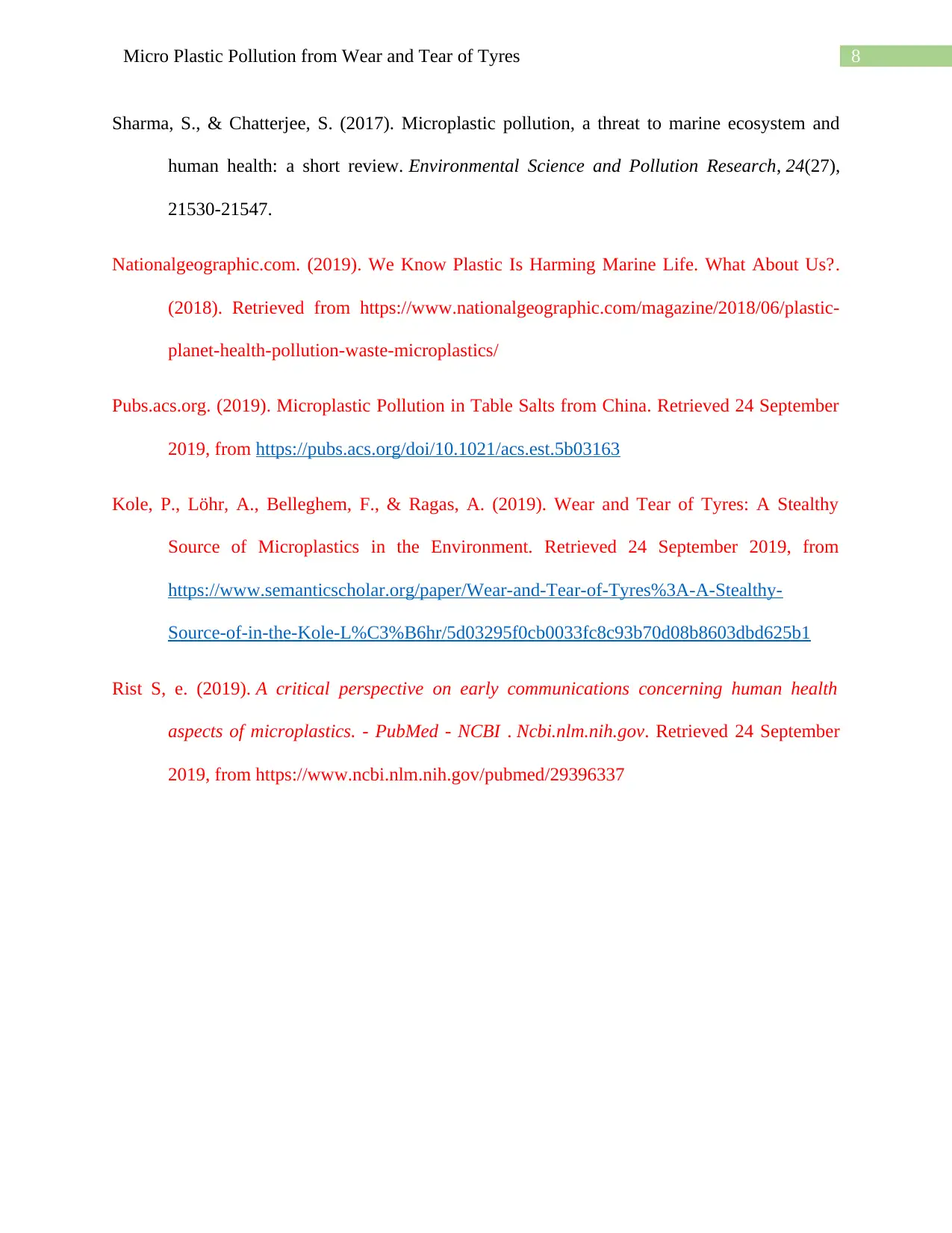
8Micro Plastic Pollution from Wear and Tear of Tyres
Sharma, S., & Chatterjee, S. (2017). Microplastic pollution, a threat to marine ecosystem and
human health: a short review. Environmental Science and Pollution Research, 24(27),
21530-21547.
Nationalgeographic.com. (2019). We Know Plastic Is Harming Marine Life. What About Us?.
(2018). Retrieved from https://www.nationalgeographic.com/magazine/2018/06/plastic-
planet-health-pollution-waste-microplastics/
Pubs.acs.org. (2019). Microplastic Pollution in Table Salts from China. Retrieved 24 September
2019, from https://pubs.acs.org/doi/10.1021/acs.est.5b03163
Kole, P., Löhr, A., Belleghem, F., & Ragas, A. (2019). Wear and Tear of Tyres: A Stealthy
Source of Microplastics in the Environment. Retrieved 24 September 2019, from
https://www.semanticscholar.org/paper/Wear-and-Tear-of-Tyres%3A-A-Stealthy-
Source-of-in-the-Kole-L%C3%B6hr/5d03295f0cb0033fc8c93b70d08b8603dbd625b1
Rist S, e. (2019). A critical perspective on early communications concerning human health
aspects of microplastics. - PubMed - NCBI . Ncbi.nlm.nih.gov. Retrieved 24 September
2019, from https://www.ncbi.nlm.nih.gov/pubmed/29396337
Sharma, S., & Chatterjee, S. (2017). Microplastic pollution, a threat to marine ecosystem and
human health: a short review. Environmental Science and Pollution Research, 24(27),
21530-21547.
Nationalgeographic.com. (2019). We Know Plastic Is Harming Marine Life. What About Us?.
(2018). Retrieved from https://www.nationalgeographic.com/magazine/2018/06/plastic-
planet-health-pollution-waste-microplastics/
Pubs.acs.org. (2019). Microplastic Pollution in Table Salts from China. Retrieved 24 September
2019, from https://pubs.acs.org/doi/10.1021/acs.est.5b03163
Kole, P., Löhr, A., Belleghem, F., & Ragas, A. (2019). Wear and Tear of Tyres: A Stealthy
Source of Microplastics in the Environment. Retrieved 24 September 2019, from
https://www.semanticscholar.org/paper/Wear-and-Tear-of-Tyres%3A-A-Stealthy-
Source-of-in-the-Kole-L%C3%B6hr/5d03295f0cb0033fc8c93b70d08b8603dbd625b1
Rist S, e. (2019). A critical perspective on early communications concerning human health
aspects of microplastics. - PubMed - NCBI . Ncbi.nlm.nih.gov. Retrieved 24 September
2019, from https://www.ncbi.nlm.nih.gov/pubmed/29396337
⊘ This is a preview!⊘
Do you want full access?
Subscribe today to unlock all pages.

Trusted by 1+ million students worldwide
1 out of 9
Related Documents
Your All-in-One AI-Powered Toolkit for Academic Success.
+13062052269
info@desklib.com
Available 24*7 on WhatsApp / Email
![[object Object]](/_next/static/media/star-bottom.7253800d.svg)
Unlock your academic potential
Copyright © 2020–2025 A2Z Services. All Rights Reserved. Developed and managed by ZUCOL.





